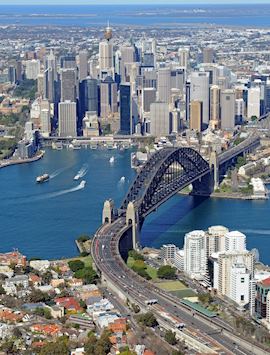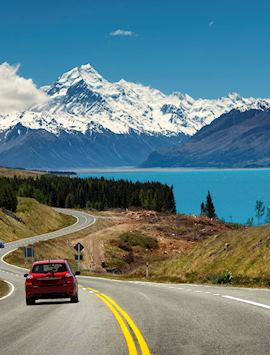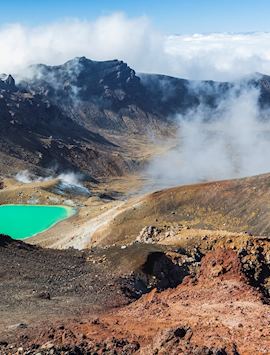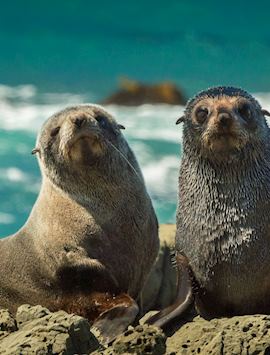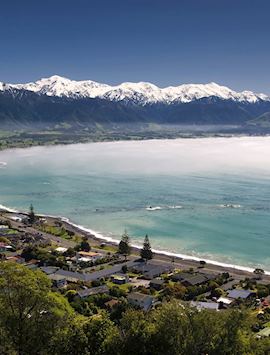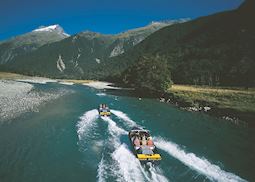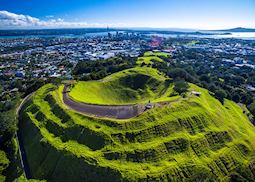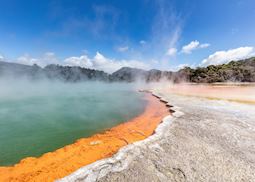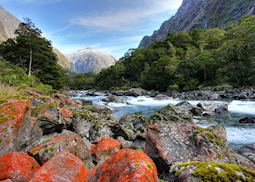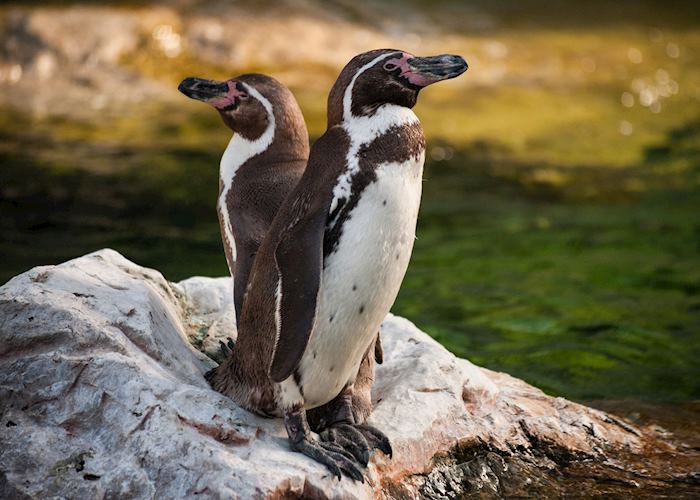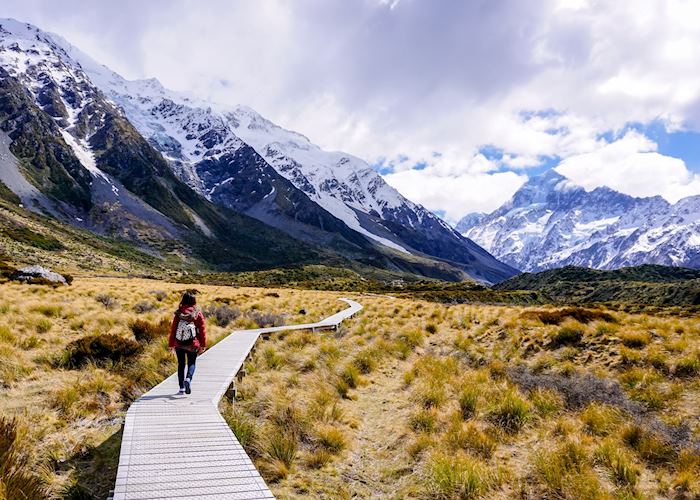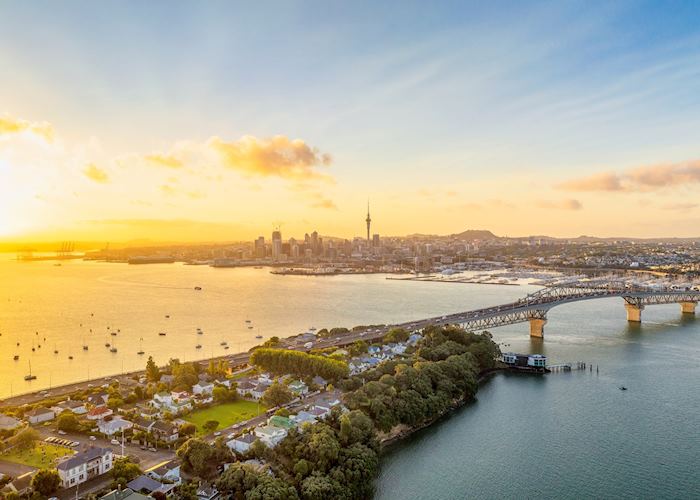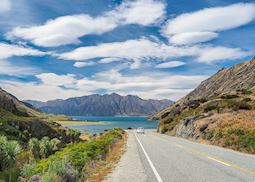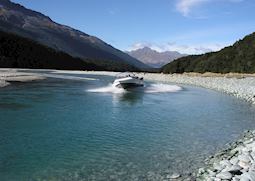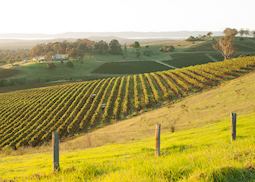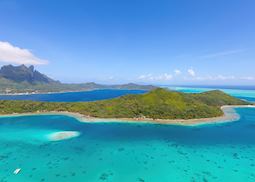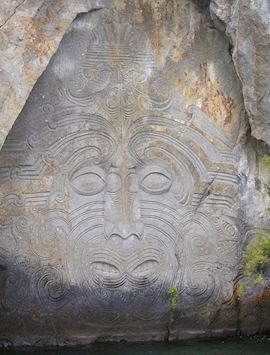

Tailor-made New Zealand holidays shaped around your passions
New Zealand has the kind of scenery that demands a standing ovation — and it’s all in such close proximity. Our specialists are passionate about helping you get out to explore it all. There are Milford Sound’s arrow-headed peaks, and stretches of sand so vast they earn outlandish names (‘Ninety Mile Beach’). Caves spangle with glow-worms like a million fairy lights. Stratovolcanoes rise above grassy plains. Ice fields career down almost to the edge of the Tasman Sea. And that’s just for starters.
Whether you’re keen to explore on foot or by car, bicycle or even helicopter (or a combination of them all), our specialists can help. They’ll devise a New Zealand holiday that allows you to take in the major destinations, as well as more out-of-the-way spots or lesser-known activities. They can recommend everything from the best Māori guides to the best places for viewing New Zealand’s unique birdlife. They can also build in time cruising from Australia to New Zealand, allowing you to cover more ground as you sail past albatross breeding colonies, search for rare Hector’s dolphins, and see a collection of historic Māori cloaks and weaponry in Wellington.
Reduced fares currently available through our airline partners
We have a number of reduced fares available with selected airline partners. Click below for further details on booking and travel periods.
View offersSuggested tours for New Zealand
Look for elusive kiwis by night as you trek through a protected reserve, learn about Māori culture at the Waitangi Treaty Ground in the Bay of Islands, and sample wines in Marlborough’s vineyards. Our range of suggested itineraries is a great starting point as you begin to plan your trip to New Zealand.
Suggested activities for New Zealand
Traverse the Southern Alps on the TranzAlpine train, soak up the landscapes on a cruise through Milford Sound, and spot whales and other sea creatures on a whale-watching cruise. Whatever your interests, our specialists will suggest experiences designed to enhance your trip to New Zealand.
-
Siberia Valley activities experience ![Jet boat, Siberia Experience]()
Siberia Valley activities experience
Lake WanakaSiberia Valley activities experience
The Siberia Experience offers you a selection of New Zealand's best adventurous activities all in one day.
View details -
Auckland highlights tour ![Mount Eden, Auckland]()
Auckland highlights tour
AucklandAuckland highlights tour
Known as the 'City of Sails', this tour is the perfect introduction to the city as you visit several points of cultural and scenic interest; including Mount Eden with its amazing 360 degree views of the city and the city's oldest park, Auckland Domain.
View details -
Milford Track day walk ![River near Milford Sound, Fiordland]()
Milford Track day walk
Milford SoundMilford Track day walk
This small group excursion gives you a taste of the majestic scenery of the Milford Track without having to dedicate five days to complete the whole trail. Your lunch is included, and complimentary tea and coffee are available at the start and end of the walk.
View details
Why travel with Audley?
- 100% tailor-made tours
- Fully protected travel
- Established for over 25 years
- 98% of our clients would recommend us
Best time to visit
Our specialists advise on the best months to visit New Zealand, including information about climate, events and festivals.
Travel advice
Practical tips for travelling to New Zealand, from social protocols to guidance on money matters, with a link to the latest FCDO travel advice.

Request our brochure
Covering all seven continents, The World Your Way shows you how you can see the world with us. It features trip ideas from our specialists alongside hand-picked stays and experiences, and introduces our approach to creating meaningful travel experiences.
New Zealand by island
If you’re planning to focus your time in New Zealand visiting one of its two main islands, you can jump into the island you're most interested in to find detailed itinerary ideas together with accommodation choices and a taster of the experiences we can offer.
New Zealand in pictures
Our expert guides to travelling in New Zealand
Written by our specialists from the viewpoint of their own travels, these guides will help you decide on the shape of your own trip to New Zealand. Aiming to inspire and inform, we share our recommendations for how to appreciate New Zealand at its best.
-
![Luxury New Zealand]()
Luxury New Zealand
New Zealand’s raft of luxury wilderness lodges allow you to retreat to the backcountry while staying in well-designed properties equipped with indulgent touches. And, they also offer one-off experiences and activities.
-
New Zealand self-drive holidays: 3 great routes ![Queenstown, South Island]()
New Zealand self-drive holidays: 3 great routes
New Zealand self-drive holidays: 3 great routes
Audley country specialist John explains why, for him, self-drive is the best way to explore New Zealand. He recommends three very different routes, from mountain passes in the South Island to forest roads in the North Island.
Read this guide -
Exploring New Zealand by campervan: an all-you-need-to-know guide ![Travelling by campervan, New Zealand]()
Exploring New Zealand by campervan: an all-you-need-to-know guide
Exploring New Zealand by campervan: an all-you-need-to-know guide
If you have ever fancied roaming New Zealand by campervan, read on. Audley specialist James shares his dos and don’ts for campervan holidays in this most outdoorsy of countries, including the most scenic (and often little-known) pitches and campsites.
Read this guide -
Luxury stays in New Zealand: four of the best luxury lodges ![Main bedroom in the owner's cottage. Rosewood Kauri Cliffs]()
Luxury stays in New Zealand: four of the best luxury lodges
Luxury stays in New Zealand: four of the best luxury lodges
Paul from our New Zealand team picks his preferred luxury lodges across both North and South Islands. How can they enhance your trip? For him, it’s about their remote locations and the experiences you can tap into.
Read this guide -
What to do in New Zealand: our highlights guide ![Jet boat on the Dart River]()
What to do in New Zealand: our highlights guide
What to do in New Zealand: our highlights guide
Enjoy New Zealand’s north and south islands with this travel guide that looks at cruising the Bay of Islands and Doubtful Sound, Rotorua’s thermal springs, the Coromandel Peninsula, whale spotting in Kaikoura, and Mount Cook and Abel Tasman national parks.
Read this guide
Other popular destinations
Still looking for ideas? If New Zealand has captured your interest, we think you might also like these destinations.



